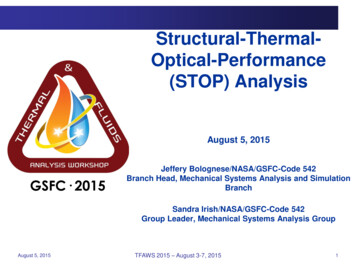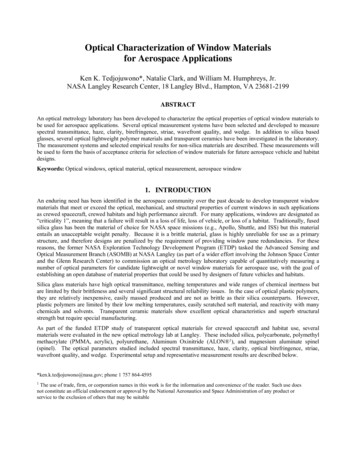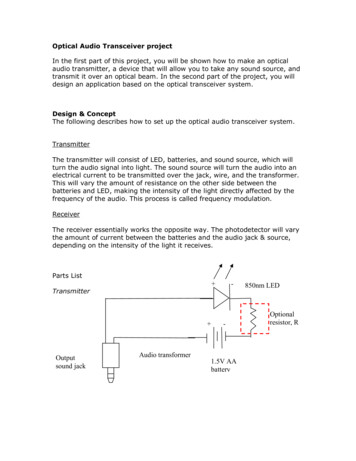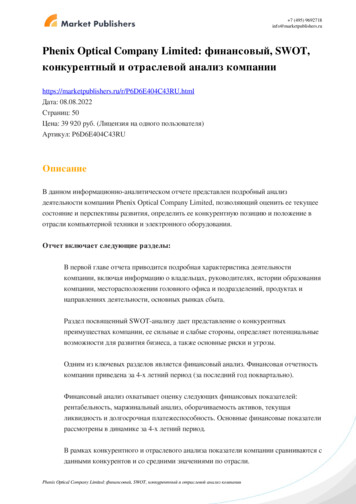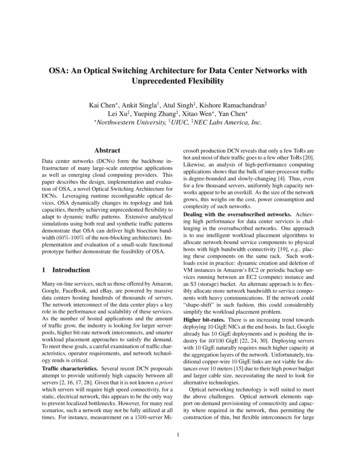
Transcription
Hindawi Publishing CorporationJournal of NanomaterialsVolume 2014, Article ID 401498, 7 pageshttp://dx.doi.org/10.1155/2014/401498Research ArticleStudy of Optical and Structural Characteristics ofCeria Nanoparticles Doped with Negative and PositiveAssociation Lanthanide ElementsN. Shehata,1,2 K. Meehan,3 M. Hudait,1 N. Jain,1 and S. Gaballah21Bradley Department of Electrical and Computer Engineering, Virginia Polytechnic Institute and State University,Blacksburg, VA 24061, USA2Department of Engineering Mathematics and Physics, Faculty of Engineering, Alexandria University, Alexandria 21544, Egypt3School of Engineering, University of Glasgow, Glasgow G12 8QQ, UKCorrespondence should be addressed to N. Shehata; nader83@vt.eduReceived 16 September 2014; Revised 5 November 2014; Accepted 8 November 2014; Published 30 November 2014Academic Editor: Fathallah KarimzadehCopyright 2014 N. Shehata et al. This is an open access article distributed under the Creative Commons Attribution License,which permits unrestricted use, distribution, and reproduction in any medium, provided the original work is properly cited.This paper studies the effect of adding lanthanides with negative association energy, such as holmium and erbium, to ceriananoparticles doped with positive association energy lanthanides, such as neodymium and samarium. That is what we called mixeddoped ceria nanoparticles (MDC NPs). In MDC NPs of grain size range around 6 nm, it is proved qualitatively that the conversionrate from Ce4 to Ce3 is reduced, compared to ceria doped only with positive association energy lanthanides. There are manypieces of evidence which confirm the obtained conclusion. These indications are an increase in the allowed direct band gap whichis calculated from the absorbance dispersion measurements, a decrease in the emitted fluorescence intensity, and an increase in thesize of nanoparticles, which is measured using both techniques: transmission electron microscope (TEM) and X-ray diffractometer(XRD). That gives a novel conclusion that there are some trivalent dopants, such as holmium and erbium, which can suppress Ce3 ionization states in ceria and consequently act as scavengers for active O-vacancies in MDC. This promising concept can developapplications which depend on the defects in ceria such as biomedicine, electronic devices, and gas sensors.1. IntroductionIn last few years, oxides with the cubic fluorite structurelike cerium oxide (ceria) nanoparticles have been extensivelystudied due to their potential uses in various applications,such as UV absorbents [1], polishing media as luminescentmaterial [2], neuroprotective applications [3], and catalystsin the fuel cell technology [4]. Doping ceria with trivalentelements changes the structural properties, compared toundoped ceria, such as decreasing in the lattice parameterwhich is caused by increasing the conversion process ofCe 4 ions to Ce3 [5]. However, it is proved theoreticallythat few trivalent dopants such as scandia (Sc3 ), which hasnegative association energy between vacancy and dopant,can act as scavengers for oxygen vacancies (𝑉O ) [6]. Thatmay give an impression that perhaps not all trivalent dopedelements increase the formation of oxygen vacancies in ceriananoparticles. Many methods have been used to producedoped ceria nanoparticles such as chemical precipitation [7],hydrothermal synthesis [8], and solid-state reaction method[9]. Compared to other methods, precipitation is more attractive due to the cheap salt precursors, simple operation, andease of mass production [10]. In this work, ceria nanoparticlesare synthesized using chemical precipitation within two doping trivalent lanthanide elements; one has positive associationenergy (𝐸ass ), such as neodymium and samarium, and theother one has negative association energy such as holmiumand erbium [11, 12]. That is what we called mixed doped ceriananoparticles (MDC NPs). The positive sign of 𝐸ass indicatesthat the dopant can repel the O-vacancy or does not f
important because it helps in the conversion of Ce(OH)3 toCeO2;Ce 4 ionsandthentoCe 2 O3;Ce 3 ions[24,25]. However, the selected temperature is not relatively high, compared to [26, 27], to reduce the agglomeration of the formed nanoparticles. The stirred solution is kept in the heatedwaterpathfor1.5hours.Inthesecondstageofthe


